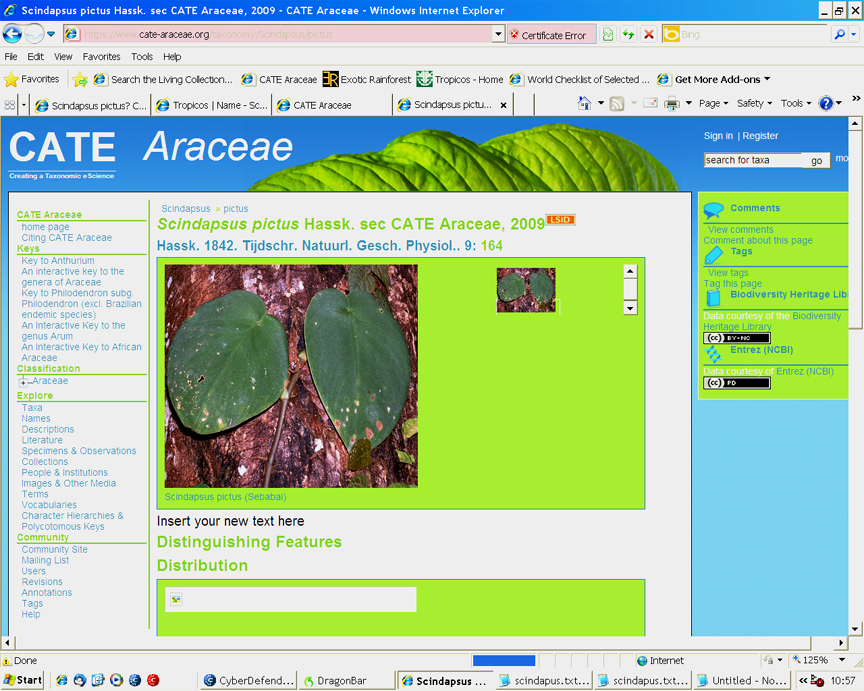![]()
Aroids and other genera in the Collection
Take the Tour Now?
Orchids
The
Exotic Rainforest
Plants in
the Exotic Rainforest Collection
Images on this website are
copyright protected. Please contact us before any reuse.
In
depth information on how to grow
Philodendron
species,
Click this Link
Within our collection we have many species of Philodendron.
If you are seeking other photos,
click this link
This plant is currently being
studied
by Dr. Thomas B. Croat at the Missouri Botanical Garden
as voucher number
Croat 101488, The information on this page is little
more
than my personal
notes and observation but includes
scientific input by qualified
aroid botanists
and experts. Information from their published papers is also included.
If you believe you have this species please be aware there are several
species identified to science with a
similar appearance. Please read these notes carefully to compare this
specimen to your plant.
Philodendron
Species unknown
Voucher
number Croat 101488
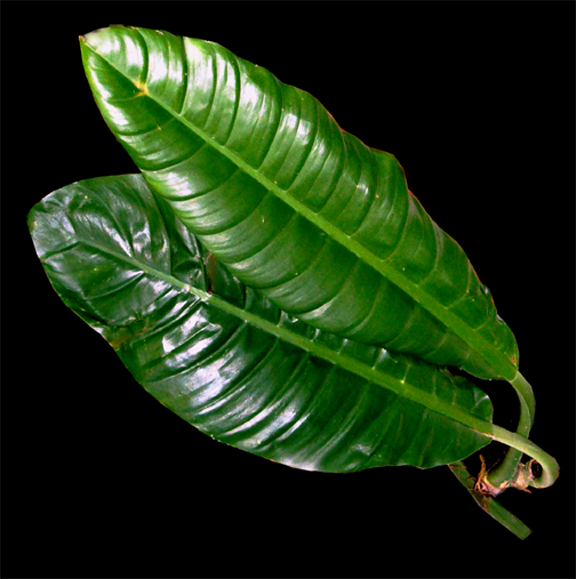
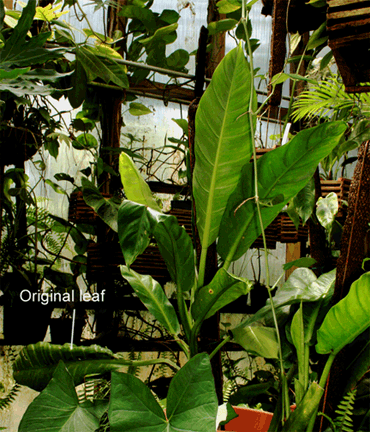
Philodendron
Species unknown
Purportedly
collected near
Limón,
Indanza Morona-Santiago, Ecuador
Text and photos compiled by Steve Lucas
Does it have a monopodial or a sympodial growth
form?
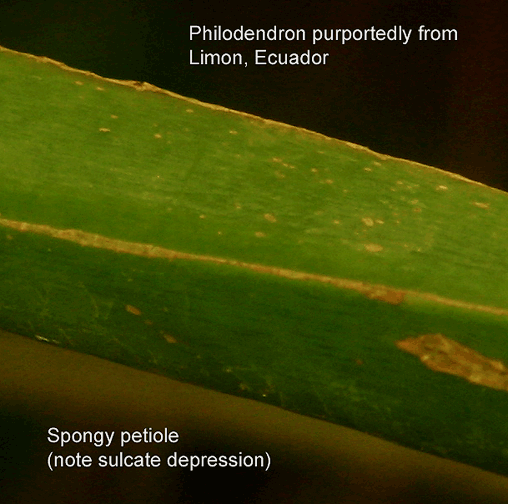 Aroid
botanist Dr. Thomas B. Croat Ph.D., P.A. Schulze Curator of Botany
of the Missouri Botanical Garden in St. Louis who is one of the world's
leading aroid scientists briefly examined the specimen shown
on this page in Miami in September, 2008. He again examined it on
June 19, 2009 in his office
as well as having reviewed the photos on this page on more than one
occasion. He has also seen in personally in the Exotic Rainforest
atrium and does not appear to believe this
Philodendron has
been identified to science.
Aroid
botanist Dr. Thomas B. Croat Ph.D., P.A. Schulze Curator of Botany
of the Missouri Botanical Garden in St. Louis who is one of the world's
leading aroid scientists briefly examined the specimen shown
on this page in Miami in September, 2008. He again examined it on
June 19, 2009 in his office
as well as having reviewed the photos on this page on more than one
occasion. He has also seen in personally in the Exotic Rainforest
atrium and does not appear to believe this
Philodendron has
been identified to science.
A leaf and petiole sample as well as several complete roots and a cataphyll have been delivered to Dr. Croat for drying to be deposited in the Missouri Botanical Garden herbarium. These samples are currently under study by Dr. Croat as voucher number Croat 101488. Once the specimen produces an inflorescence which can be collected and preserved for study an entire plant cutting will be collected to be grown in the MOBOT living plant collection. At this point no scientific name has been assigned but one is under consideration. A full set of photos and measurements was delivered to Dr. Croat's office in early December, 2009. (Note: In the first week of May, 2010 a cluster of growth began on the plant that Dr. Croat confirmed was the formation of an inflorescence or inflorescences. A photo of that cluster can be found later in this article.)
The specimen was acquired on September 19 at the 2008 International Aroid Society Show and Sale in Miami, FL. Ecuagenera, a rare plant vendor from Ecuador, was just opening a box of plants and this one was on the top of the pile of plants. Due to my interest in Philodendron and Anthurium with elongated lanceolate leaves I immediately asked the price even though there was no name on the plant. Although I also asked where the specimen originated in the country the seller was hesitant to disclose the information for understandable reasons and appeared to know little about the origin of the plant. He did volunteer it had been collected "near" Limón. As a result of some of the odd characteristics of the specimen I immediately took the newly acquired plant directly to Dr. Croat who was just across the room.
Tom's first comment was the specimen's petioles were sulcate and also indicated he had never seen the species before. Sulcate can indicate one or both of two characteristics. The term can apply to a plant with a "C" shaped groove known as a sulcus running down the axis of a petiole, midrib or other plant feature or the plant has fine parallel grooves on one or more of the same plant parts. This specimen demonstrates both.
In an email received in mid April, 2009
Dr. Croat stated,
"I had another look at the Philodendron. It
most closely resembles
Philodendron parvilobum Croat but that species has little basal lobes. It
somewhat resembles Philodendron heterophyllum
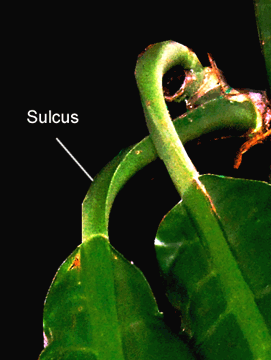 Poeppig but I don’t think
that it is that either."
An enlarged petiole photo of this and other characteristics can be found at
the conclusion of this
article.
Poeppig but I don’t think
that it is that either."
An enlarged petiole photo of this and other characteristics can be found at
the conclusion of this
article.
Limón, Indanza Morona-Santiago Province, Ecuador is south of Quito and the province borders with Peru found in the central southeastern part of the county. The economy of the region relies on rain forest tourism and the national Sangay park. According to my friend Elizabeth Campbell who lives in Quito, Limón has very high humidity and remains between 80 to 90%. The area is midway between a wet and dry rain forest and is at an elevation of approximately 500 to 600 meters (1,650 to 2,350 feet) above sea level. The temperature averages 35 C (95 F) in the summer and close to 30 C (86 F) during the wet season. Since the plant is an epiphyte (ep-a-FIT) it would normally grow in the mid to upper canopy which is typical of the type of forest in the region. As a result it should normally receive partial sun. Aroids in that area of Ecuador normally produce an inflorescence during the transition between the wet and dry seasons. We have duplicated these conditions as closely as possible in our atrium in order to encourage the plant to begin the process of reproduction.
It must be noted the exact collection data was not recorded and neither the area nor point of collection can be verified.
The genus
Philodendron is divided into three subgenera which include subgenus
Philodendron, subgenus Meconostigma and subgenus
Pteromischum. Those subgenera are then further divided into sections
and subsections based on the
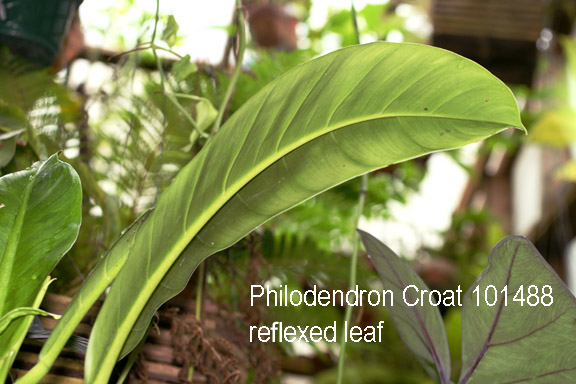 individual characteristics of the plant.
individual characteristics of the plant.
After
reexamining the specimen in his office Dr, Croat indicated the Philodendron was
a member of Philodendron subsection Glossophyllum
Schott and is placed in series Glossophyllum. Other
specimens in the Exotic Rainforest collection in this
section/series which are somewhat similar include Philodendron pseudauriculatum
and Philodendron bakeri. The top photo at the top of this
page was taken on August 11, 2009, eleven months after the
plant was acquired. The second photo shows the plant as it
appeared on the day it was added to the collection in Northwest Arkansas. The blade indicated
on the
left of the photo is the
higher of the two blades in the second photo on this page. The other
blade in the same photo has since died and been removed.
Philodendron
species in Philodendron series
Glossophyllum possess leaves that are more or less oblong and as
well as acute (tapering to a point) but may frequently be cordulate to
sub-cordate (less than hear shaped) at the base. The primary lateral
leaf veins should be distinct and the stems are typically scandent and
specimens often possess an annulus (colored ring).
Scandent indicates a plant grows pressed close to its host.
Our
specimen has demonstrated itself to be an epiphytic or hemiepiphytic
climbing vine. The petioles which connect the leaf blade to the stem are
spongy to the touch as well as
sulcate (broadly canaliculate) to almost "D" shaped
at the apex but shallower near the base.
The blades are subcoriaceous (less than leathery) with a rubber-like consistency as well as being oblanceolate (both oblong and lance shaped) . As they mature they reflex and turn back.
The mid rib and petioles appear sulcate although the midrib is sharply convex near the base. Sulcate indicates either a canal known as a sulcus or having numerous fine parallel grooves.
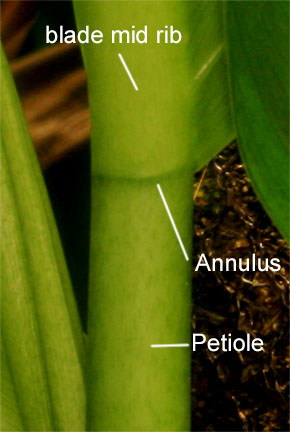 The veins on any leaf are divided into classifications
which include the midrib, primary lateral veins, interprimary
veins and tertiary or
minor veins The midrib at the center of any leaf of the
Philodendron discussed here
is flattened
to slightly to moderately convex on the adaxial (upper) surface but
sharply convex and curved
on the abaxial (lower) surface. The midrib is sulcate due to small
parallel grooves that run along the axis.
The veins on any leaf are divided into classifications
which include the midrib, primary lateral veins, interprimary
veins and tertiary or
minor veins The midrib at the center of any leaf of the
Philodendron discussed here
is flattened
to slightly to moderately convex on the adaxial (upper) surface but
sharply convex and curved
on the abaxial (lower) surface. The midrib is sulcate due to small
parallel grooves that run along the axis.
The
support for the leaves of an aroid are known as petioles. The petiole
is a shoot-like stalk that connects the lamina of the leaf at the petiole's
apex (top) to the specimen's stem which is found growing at the base of the
petiole. The petioles emerge from buds along the stem. Their
purpose is to support the leaf as well as transfer water and nutrients
though their own cellular structure known as the xylem.
In most Philodendron species cataphylls would surround each unfurling new leaf. A cataphyll is a bract-like modified leaf that surrounds any new leaf and whose purpose is to protect the new leaf during development. On the new growth of this specimen rather than a cataphyll the specimen produced a sheath-like double ribbed prophyll which is closely related to a cataphyll.
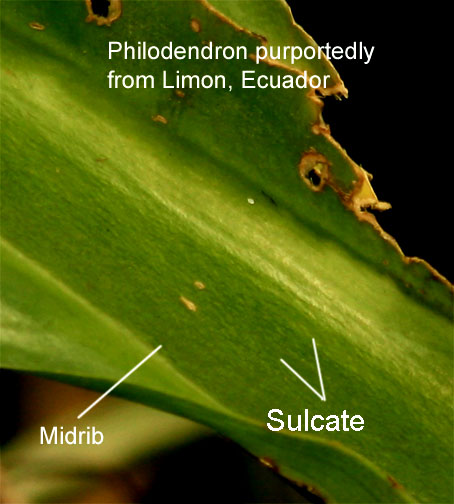 After consulting with my friends
and aroid experts Julius Boos and Leland
Miyano I developed a somewhat better understanding of the slight
difference between a cataphyll and a prophyll.
At one time I thought the reduced
foliar leaf blade (simply a blade that does not grow to its maximum
potential) I was at first seeing was a cataphyll. A reduced leaf blade
may be
produced as a result of the plant temporarily changing its shoot growth from
a
monopodial growth form to a sympodial growth but is common in sympodial
species. However, Leland
explained the plant could still be monopodial,
"Your plant is
monopodial in it's current juvenile/sub adult stage. It is a stage
of it's ontology."
Ontogeny is the normal
growth of a living organism from early juvenile to adult or the process of an
organism growing and the events involved in the changes to the
organism as it grows from a seedling to a fully mature specimen. P. B. Tomlinson
in his Anatomy of the Monocotyledons: Gramincae. 1960. -Vol.2: Palmae
states within aroids, based on the work of Dr. Tom Ray of the
University of Oklahoma, published in 1986, monopodial growth forms have the base of the
petiole ensheathing the stem while in sympodial growth forms the base of
the petiole does not ensheath the stem.
After consulting with my friends
and aroid experts Julius Boos and Leland
Miyano I developed a somewhat better understanding of the slight
difference between a cataphyll and a prophyll.
At one time I thought the reduced
foliar leaf blade (simply a blade that does not grow to its maximum
potential) I was at first seeing was a cataphyll. A reduced leaf blade
may be
produced as a result of the plant temporarily changing its shoot growth from
a
monopodial growth form to a sympodial growth but is common in sympodial
species. However, Leland
explained the plant could still be monopodial,
"Your plant is
monopodial in it's current juvenile/sub adult stage. It is a stage
of it's ontology."
Ontogeny is the normal
growth of a living organism from early juvenile to adult or the process of an
organism growing and the events involved in the changes to the
organism as it grows from a seedling to a fully mature specimen. P. B. Tomlinson
in his Anatomy of the Monocotyledons: Gramincae. 1960. -Vol.2: Palmae
states within aroids, based on the work of Dr. Tom Ray of the
University of Oklahoma, published in 1986, monopodial growth forms have the base of the
petiole ensheathing the stem while in sympodial growth forms the base of
the petiole does not ensheath the stem.
The subject of monopodial compared to sympodial growth along with that of prophylls versus cataphylls is complex and this writer makes no claim to have more than a very basic understanding of the subject. Several noted aroid botanists prefer not to recognize the term "prophyll" as of any consequential value while others use it regularly in their journals and published articles, To fully understand the growth forms in this plant would require the new growth shown to be dissected and destroyed, something I am unwilling to allow. As a result, my comments are based solely on reading as much scientific material as I can locate including portions of Tom Ray's work published in 1986, Dr. Simon Mayo's A Revision of Philodendron Subgenus Meconostigma (Araceae) published in 1991, information found in the scientific text The Genera of Araceae by Simon Mayo, Peter Boyce and Josef Bogner along with explanations shared by qualified experts.
My limited understanding is a monopodial growth
is composed of a single stem with roots, petioles, blades etc. that grow
upwards attached to its host. The name comes from the Greek words "mono"
(single) and "podial" (foot). A monopodial growth terminates in the production of an inflorescence but
then new growth continues to
climb upwards on the host. In monopodial growth the stem may grow
side branches while also continuing to grow from the tip. In
monopodial growth when a new blade is formed a cataphyll normally
encases the new shoot. The word "terminates" as used in
this article does not
indicate the end of all growth. Instead the growth may slightly
reroute and continue. The plant is actually
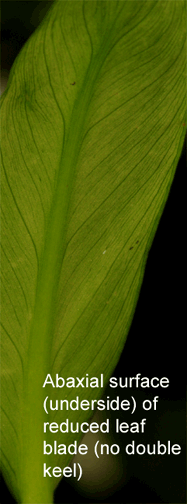 producing a new growth
section which will include more leaves as well as cataphylls/prophylls and inflorescences.
Some of the inflorescences often abort before becoming fully developed.
producing a new growth
section which will include more leaves as well as cataphylls/prophylls and inflorescences.
Some of the inflorescences often abort before becoming fully developed.
A prophyll is always the first unit to begin growth on the new stem in a sympodial growth form. The new shoot begins with a prophyll that does not necessarily encase the new blade or a set of several leaf blades is followed by a leaf that is often reduced in size . Sympodial growth terminates, or ends the sequence, with the production of an inflorescence which completes the sympodial growth sequence but does not end the growth of the plant. Instead, the growth continues in a slightly rerouted state known as a "continuation shoot".
My
friend Julius explains further,
"Bear in mind that in even a ''simple'' and easily observed example of
sympodial growth such as observing a young Meconostigma, the
inflorescence is generally aborted while
 still microscopic and still
well hidden inside the leaf sheath, so the visible growth pattern is---
prophyll, then new leaf, (the bloom is not produced and aborts while
inside and hidden in the new leaf sheath), then new prophyll, then
another new leaf, etc. The plant will bloom when adult size is attained
or the blooming season comes around."
still microscopic and still
well hidden inside the leaf sheath, so the visible growth pattern is---
prophyll, then new leaf, (the bloom is not produced and aborts while
inside and hidden in the new leaf sheath), then new prophyll, then
another new leaf, etc. The plant will bloom when adult size is attained
or the blooming season comes around."
In the scientific text The Genera of Araceae (TGOA) the definition of prophyll is:
"prophyll--the first leaf of a branch or a
sympodial unit; in
all Araceae almost always a 2-keeled cataphyll, often confused w/
cataphyll : cataphyll refers to a particular type of morphology (reduced
leaf), prophyll refers to the position of the leaf along a branch."
Therefore a prophyll is a specialized leaf form (specialized type) of cataphyll
with two keels on the abaxial surface (underside).
Aroid botanist Dr.
Alistair Hay explains a
"sympodial unit terminates in an
inflorescence, at which point a new unit starts, first a prophyll, then
a leaf or a set of several leaves, then another inflorescence which gets
displaced and may appear to be lateral, this inflorescence ends this
sympodial unit/sequence."
Alistair sent this personal note on this plant having a prophyll
versus a cataphyll, "There is a strict definition
of a prophyll: the first foliar organ on a new axis (a special sort of
cataphyll), and it always has distinctive form with two keels, whereas
an ordinary cataphyll has one or none."
As
noted by Alistair in his
email, and after
closely examining a photo of the abaxial surface (underside) of
the reduced blade (smaller in size than normal) that appeared to me to be a cataphyll I can see no evidence of a "double keel".
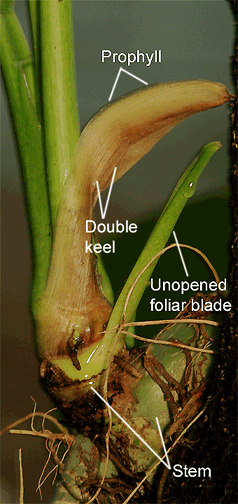 Although I had at first thought the reduced foliar leaf was a
"cataphyll" since it was the first growth I noticed But
then based on the suggestions of Leland I began I realized there the reduced
leaf did not possess a double keel (two ribs). Leland suggested I look elsewhere and
indeed a prophyll could be observed with the double keels easily seen.
In time the prophyll reflexes, dies and drops from the plant. The prophyll in a reflexed position can be seen
above to the right. A prophyll in the erect position before reflexing
(turning back) can be seen
to the left above.
Although I had at first thought the reduced foliar leaf was a
"cataphyll" since it was the first growth I noticed But
then based on the suggestions of Leland I began I realized there the reduced
leaf did not possess a double keel (two ribs). Leland suggested I look elsewhere and
indeed a prophyll could be observed with the double keels easily seen.
In time the prophyll reflexes, dies and drops from the plant. The prophyll in a reflexed position can be seen
above to the right. A prophyll in the erect position before reflexing
(turning back) can be seen
to the left above.
Shortly after receiving
Alistair's note I received the following from aroid botanist Dr. Simon
Mayo of the Royal Botanic Garden Kew in London. Although somewhat
technical any serious aroid collector should be able to appreciate the
detail in Simon's response,
"I would agree
with Alistair about this. The most common architecture in Philodendron
is for each unit to consist of a prophyll with two keels followed by a
foliage leaf with virtually no sheath (this is the situation in a plant
which isn't flowering but is mature). However, when a side bud develops,
e.g. following damage to the main shoot as Alistair says, you get a
different sequence. There is actually a prophyll with two keels but it's
so small you won't see it, and this is followed by a series of
cataphylls (foliar organs without differentiated blades and usually a
single keel), which transform into foliage leaves with more and more
well developed blades; these will have well-developed sheaths because
this young shoot starts off in the monopodial mode (continuous shoot
growth from the same apex). However, at some point in the sequence of
growth of this side shoot, there will be a switch to sympodial growth,
where you get the normal mature succession of prophyll and sheath less
foliage leaf.
The differentiation of cataphylls and prophylls can seem very confusing.
The prophyll is the first foliar organ on a new axis but a cataphyll is
any foliar organ that has no differentiation of petiole and blade -
cataphylls basically seem more like a sheath. So the definition of a
cataphyll is not about its position but about its form. So this means
it's possible to have prophylls which are cataphylls and cataphylls
which are not prophylls; also it's possible to have prophylls which have
blades and cataphylls which are prophylls!! The usual situation is that
prophylls are also cataphylls (i.e. sheath-like and no blade) and have
two keels. The foliar organs which follow a prophyll are very commonly
cataphylls, in all sorts of aroids, think of a developing Amorphophallus
inflorescence for example. However, as Philodendron shows, a prophyll
may be followed directly by a full blown foliage leaf. Anthurium's
normal architecture has a prophyll (in the form of a cataphyll) followed
by a cataphyll followed by a foliage leaf. in each sympodial unit. Tom
Ray, who studied this subject in great detail in the 1980's used the
term mesophyll for the cataphylls which followed a prophyll, and the
term "reduced leaf" for a leaf which is intermediate between a cataphyll
and a properly developed foliage leaf. An example here is is Monstera,
where it is very common for the leaf in whose sheath the inflorescence
appears has a much reduced blade compared with those immediately
preceding it."
Including the "reduced leaf
blade"
as of early May, 2009 there were
five blades open. Many of the leaf blades did not have an
ensheathing cataphyll (prophyll). By early August the specimen had produced a total
of ten new blades but none were en-sheathed. Although no
ensheathing cataphyll has been observed yet
the 10th leaf blade finally produced the first large cataphyll which was
also double keeled. Finally, on August 12, 2009 the
eleventh blade began to emerge and it was clearly obvious it would be fully
en-sheathed.
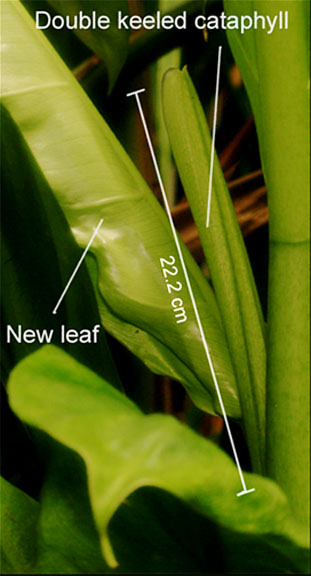 The prophylls were there on
all the
previous leaves but were simply too small to be seen. The second
visible
prophyll measuring 11.5 cm (4.5 inches) emerged with the fourth foliage
leaf blade. Incidentally, the
fourth foliage leaf to emerge produced the second prophyll in exactly the
manner as described by Dr. Mayo above,
"The most
common architecture in Philodendron is for each unit to consist of a
prophyll with two keels followed by a foliage leaf with virtually no
sheath (this is the situation in a plant which isn't flowering but is
mature). However, when a side bud develops, e.g. following damage to the
main shoot as Alistair says, you get a different sequence. There is
actually a prophyll with two keels but it's so small you won't see it,
and this is followed by a series of cataphylls (foliar organs without
differentiated blades and usually a single keel), which transform into
foliage leaves with more and more well developed blades; these will have
well-developed sheaths because this young shoot starts off in the monopodial mode (continuous shoot
growth from the same apex). However, at some point in the sequence of
growth of this side shoot, there will be a switch to sympodial growth,
where you get the normal mature succession of prophyll and sheath less
foliage leaf."
See progression of photos below.
The prophylls were there on
all the
previous leaves but were simply too small to be seen. The second
visible
prophyll measuring 11.5 cm (4.5 inches) emerged with the fourth foliage
leaf blade. Incidentally, the
fourth foliage leaf to emerge produced the second prophyll in exactly the
manner as described by Dr. Mayo above,
"The most
common architecture in Philodendron is for each unit to consist of a
prophyll with two keels followed by a foliage leaf with virtually no
sheath (this is the situation in a plant which isn't flowering but is
mature). However, when a side bud develops, e.g. following damage to the
main shoot as Alistair says, you get a different sequence. There is
actually a prophyll with two keels but it's so small you won't see it,
and this is followed by a series of cataphylls (foliar organs without
differentiated blades and usually a single keel), which transform into
foliage leaves with more and more well developed blades; these will have
well-developed sheaths because this young shoot starts off in the monopodial mode (continuous shoot
growth from the same apex). However, at some point in the sequence of
growth of this side shoot, there will be a switch to sympodial growth,
where you get the normal mature succession of prophyll and sheath less
foliage leaf."
See progression of photos below.
It now appears the plant
is indeed possesses sympodial rather than monopodial growth as was earlier
assumed. In August, 2009 the the stem
sections between most all the original blades have begun to elongate.
The petioles have begun to elongate and the roots, internodes, and nodes can now be easily observed between several of
the leaf blades (see photo below). In the earlier stages those
characteristics were so closely spaced not even the stem could be seen.
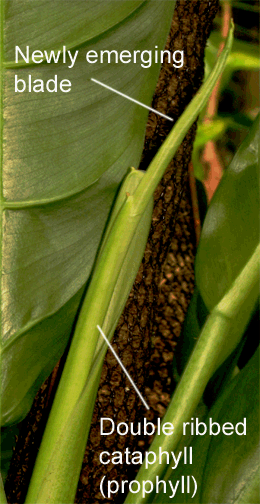 The newest leaf blades
measure approximately the same as the original blades on the specimen
when it was acquired.
Once the eleventh blade began to emerge it was obvious the plant began to
produce a leaf that was fully en-sheathed by a
double ribbed cataphyll. (See photo right).
The newest leaf blades
measure approximately the same as the original blades on the specimen
when it was acquired.
Once the eleventh blade began to emerge it was obvious the plant began to
produce a leaf that was fully en-sheathed by a
double ribbed cataphyll. (See photo right).
After reviewing this page at my request I received this extremely explanative observation from aroid botanist Peter Boyce regarding what is happening in the growth architechture of this specimen.. Pete works and teaches aroid botany in the rain forests of Malaysia. He stated, "I suspect what is happening is the 'monopodial' stem is truly a series of superimposed sympodia giving the impression of monopodial growth which could be described as physiognomically monopodial. Once in a while the plant produces a side shoot which is actually a displaced sympodium appearing sympodial. These 'displaced' sympodia are the flowering modules. It can be paraphrased as long-(lateral short)-long. I'm sorry if this is a bit convoluted since it is quite tricky to describe. There occurs a similar shoot architecture in Malaysian Rhaphidophora angusta (formerly R. pteropoda). At the moment, the plant is a bit young to be certain this is happening but given the short 'lateral jags' the main 'monopodial' axis displays I am pretty sure this new species has this architecture rather than the long-short-long architecture of species such as Philodendron linnaei. Shoot architecture is a very much overlooked aspect of Araceae taxonomy because you need to work with living plants and observe them over a long period of time."
The word "sympodia" from the root sympodium indicates a primary axis that develops from a series of short lateral branches. The primary or main axis is therefore made up of many lateral branches and each branch will grow from the one that grew just before. Each branch is an extension of the growth from the lateral axis but not from the original tip and at the end of each sympodial branch the growth will end with the production of an inflorescence.
A sympodium often zigzags in a less than regular form
as it produces new shoots. It would
appear this Philodendron has
"stacked" or "superimposed" sympodia as Pete suggested
and may have not been monopodial as was determined from photographs alone.
Certainly those experts that made that observation are highly qualified to
make such a determination but none had the opportunity to observe it
personally on a long term basis. Only additional observation by a
qualified botanist can determine that fact for certain.
Perhaps the advantage we have in learning more about the growth
architecture of this specimen is it is growing in an artificial
"rain forest" where it can be observed on a daily basis. The
disadvantage is I am not personally qualified to make any scientific
determination.
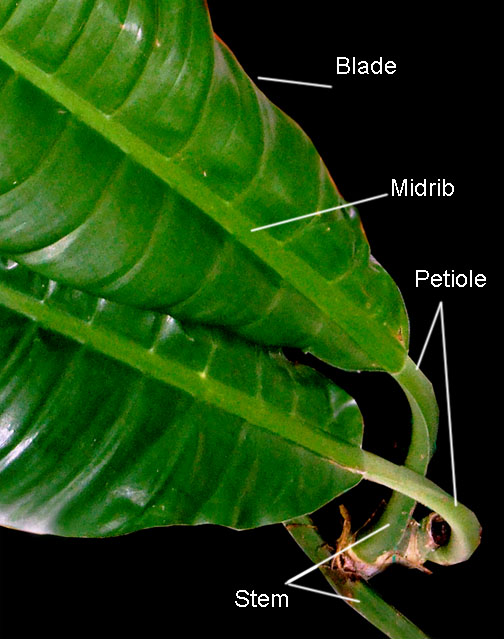 No inflorescence
had been observed but as a result of the growth architecture the sympodial
growth may soon terminate with
the production of an inflorescence as explained by Pete Boyce as
well as earlier in this article by Australian
botanist Alistair Hay. However, there is now some reason to
doubt the plant is truly sympodial.
No inflorescence
had been observed but as a result of the growth architecture the sympodial
growth may soon terminate with
the production of an inflorescence as explained by Pete Boyce as
well as earlier in this article by Australian
botanist Alistair Hay. However, there is now some reason to
doubt the plant is truly sympodial.
As of November 24, 2009 I was somewhat dubious as to whether or not this specimen is sympodial since only monopodial growth has been observed since shortly after the beginning of these observations. However, as of May 2010 the plant appears to be forming a terminal inflorescence as is common with sympodial plants. More observation will be required to be certain. As stated earlier, I delivered one of the two original leaf blades to Dr. Croat on November 21, 2009 for drying and the specimen is currently under study as voucher number Croat 101488.
For over one and one half years we have been awaiting the production of an inflorescence so the next phase of identifying the plant and possibly describing it to science can begin. In early May 2010 the development of an "inflorescence" appeared to have been finally observed. That apparent "inflorescence" turned out to be a deformed leaf so the spathe and spadix were never observed.
In September, 2010 Ecuagenera brought additional specimens of this plant to the International Aroid Show and Sale in Miami, FL. A second specimen was purchased at the same time and now resides in the Exotic Rainforest collection. A large cutting of Croat 101488 now also resides in the collection of the Missouri Botanical Garden.
In time, perhaps the plant will be rediscovered in the wild and observed in nature, A new scientific name has already been selected so now we await the production of an inflorescence.
My sincere thanks to Dr. Croat as well as all the aroid botanists and experts that have contributed to this text.
Below are additional magnified versions of some of the photos seen on this
page as well as additional photos not presented in the text.
Below: The specimen as it appeared
on August 7, 2009.
One of the original leaf blades is
noted to the left of the photo and can be seen
as the upper blade in the second photo at the very top of this page.
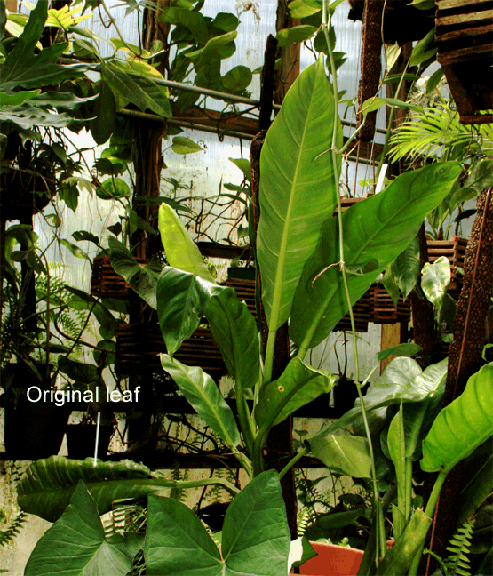
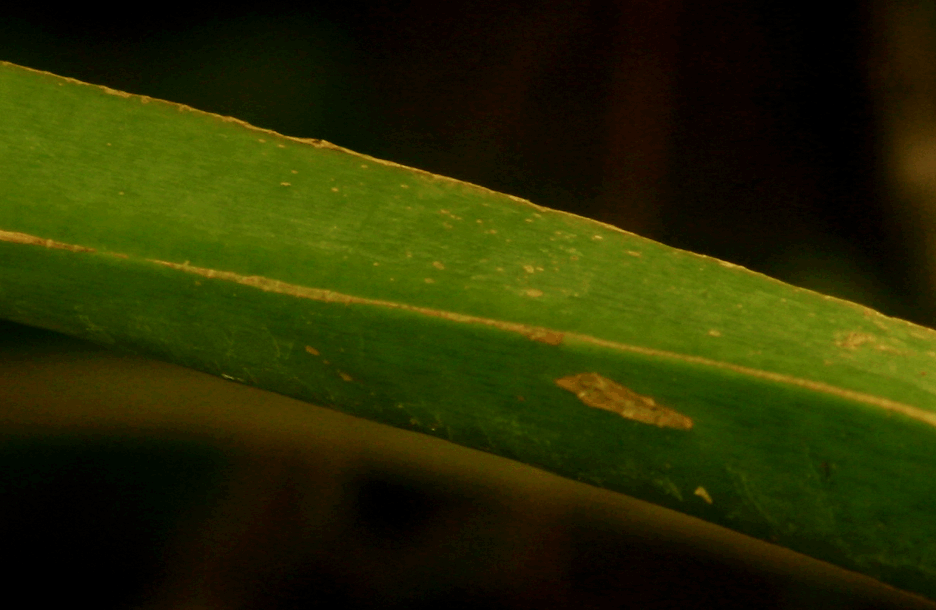
a
Above: Petioles are
may be either C or D shaped. The photo above is more canaliculate
(C
shaped), especially near the base. The petioles become
convex as they join with the blade (see below)
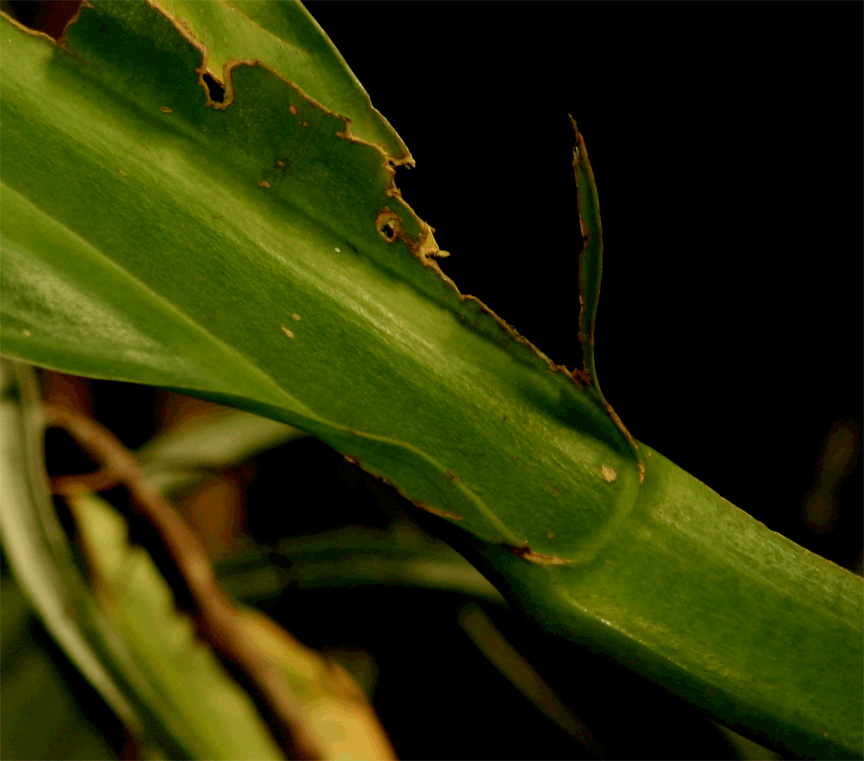
Above: Close up of blade midrib with more detailed leaf texture.
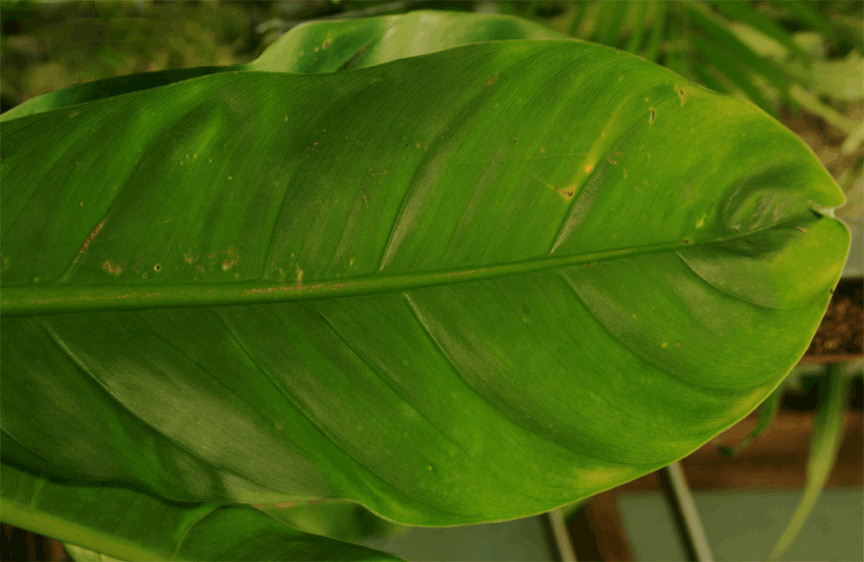
Above: Abaxial (lower) blade surface
showing convex primary lateral leaf veins
and bicolorous surface on the
underside.
Below: Extreme close-up of abaxial venation including midrib,
primary lateral
leaf veins, interprimary leaf veins and tertiary (minor) veins
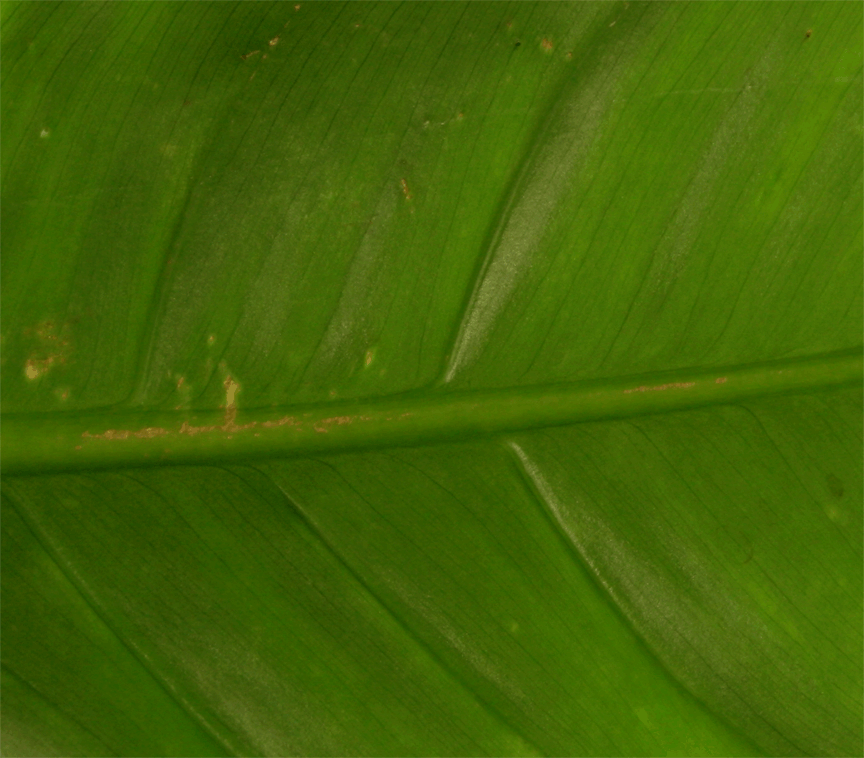
Below: Extreme close-up of abaxial venation showing midrib and
fine tertiary (minor) veins
Abaxial surface is matte but appears glossy due photo flash
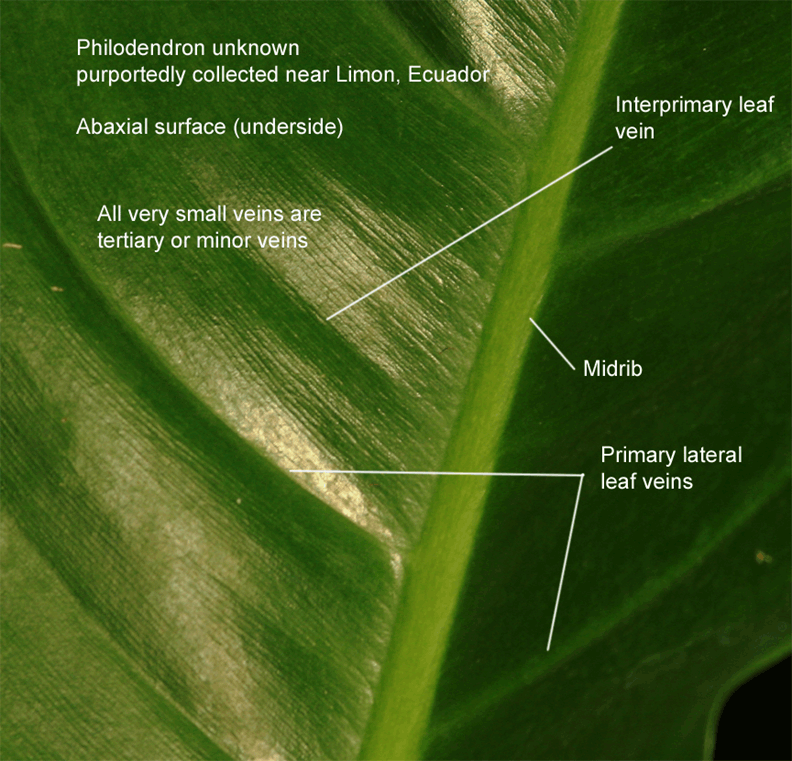
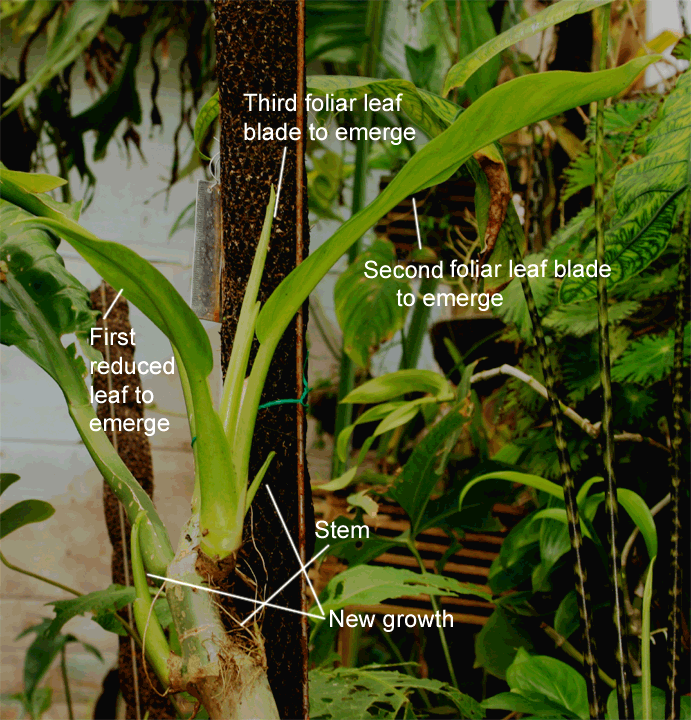
Above: The first newly emerged leaf blade was simply a reduced foliage leaf blade. Even though a cataphyll is normally seen before the blade opens, in this case there was no cataphyll enveloping the blade. Instead there was a prophyll sitting off to the side of the base of the first reduced leaf. As can be observed in this photo a second and third foliar leaf soon formed while additional new growth is visible on the stem.
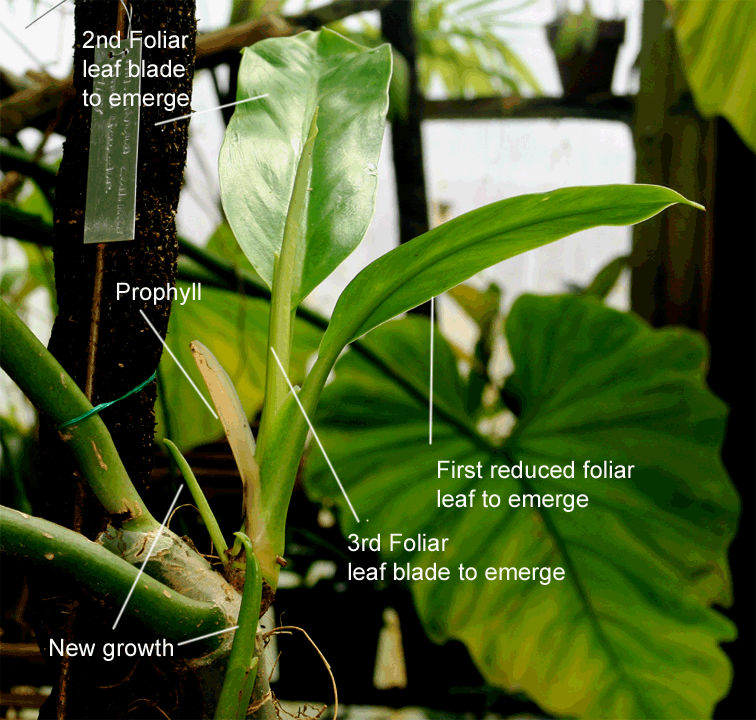
Above: The fourth leaf blade as well as the second visible prophyll produced in the exact progression as
described by
Dr. Simon Mayo in the text above The
sequence of growth shown is from the side shoot caused when the plant was
cut during collection in Ecuador, Note the change to
sympodial growth where the mature plant succession of prophyll and sheath-less foliage leaves
are followed by another prophyll.
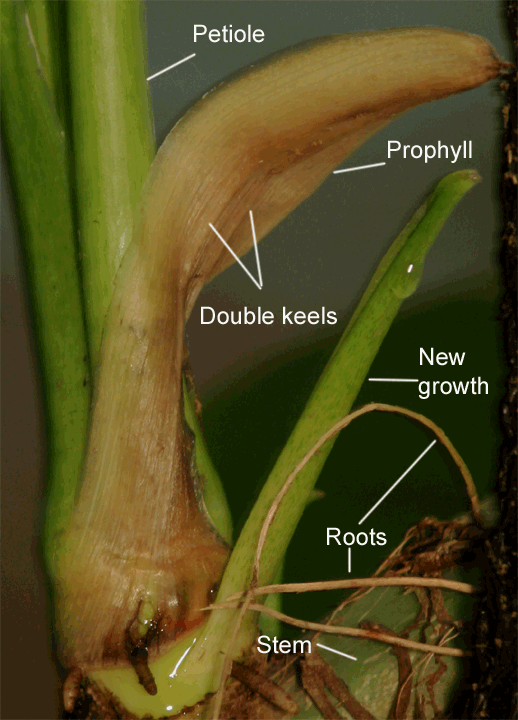
Above: Prophyll reflexing, turning brown and
beginning to die.
Soon after it dropped from the plant.
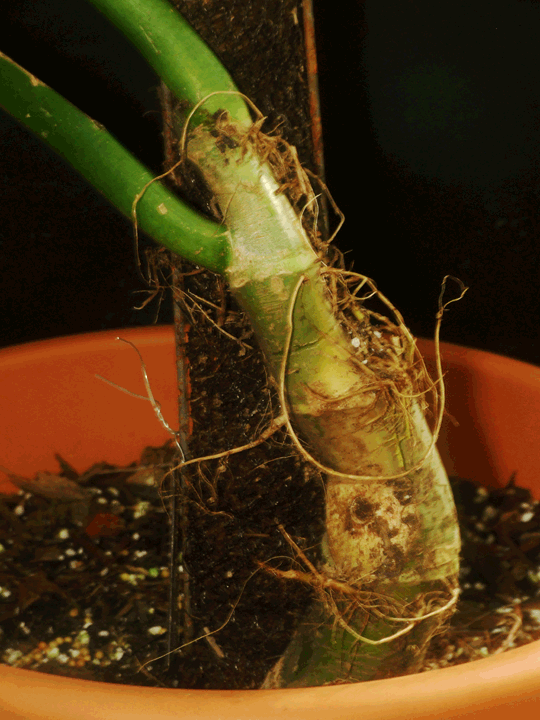
Above: Stem with relatively fine roots and pubescence.
Internodes measure 6.35 to 7.6 cm (2.5 to 3 inches).
Below: Aerial roots growing from the stem.
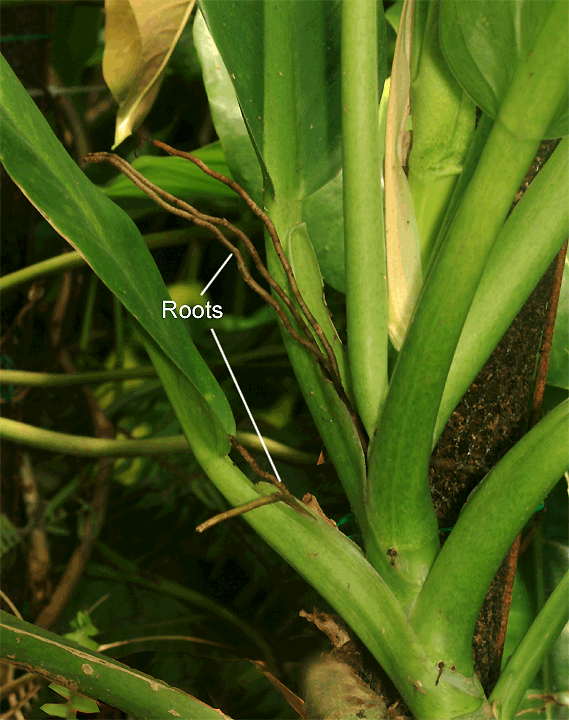
Below: Double keeled cataphyll developing alongside blade #10
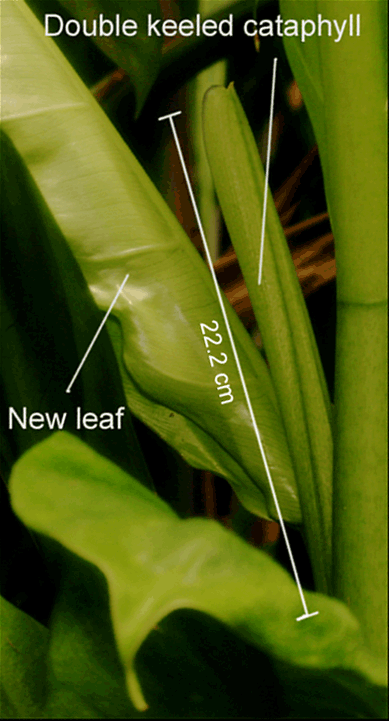
Below: Double keeled cataphyll developing en-sheathing blade #11
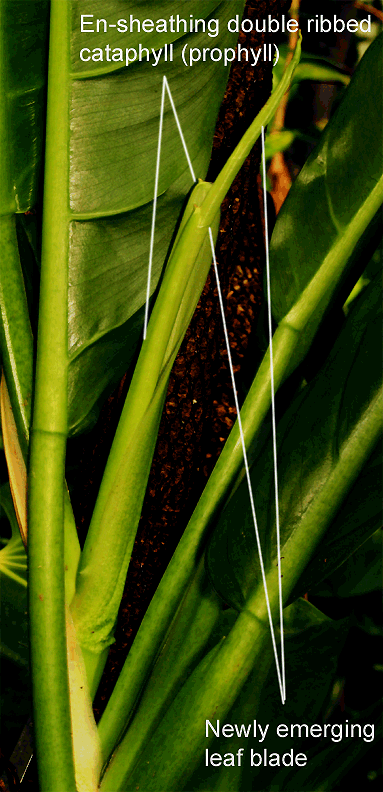
Join the International Aroid Society: http://www.exoticrainforest.com/Join%20IAS.html
If you are seeking information on other rare
species, click on "Aroids and other genera in the Collection" at the top and look for the
